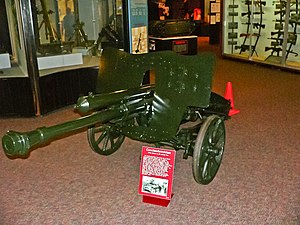| 4.7 cm KPÚV vz. 38 | |
|---|---|
 In the United States Army Ordnance Museum In the United States Army Ordnance Museum | |
| Type | Anti-tank gun |
| Place of origin | Czechoslovakia |
| Service history | |
| In service | 1939 - Present |
| Used by | Czechoslovakia Nazi Germany Kingdom of Yugoslavia Romania |
| Wars | World War II |
| Production history | |
| Designed | 1936 |
| Manufacturer | Škoda Works |
| Produced | 1939–1940 |
| Specifications | |
| Mass | 590 kg (1,300 lbs) |
| Barrel length | 2.04 m (6 ft 8 in) L/43 |
| Diameter | 4.7 cm |
| Crew | ? |
| Shell | Fixed QF 47×405 mm R |
| Shell weight | 1.6 kg (3 lb 8 oz) |
| Caliber | 47 mm (1.85 in) |
| Carriage | Split trail |
| Elevation | -8° to +26° |
| Traverse | 50° |
| Muzzle velocity | 775 m/s (2,542 ft/s) |
| Maximum firing range | 4,000 m (4,375 yds) |
The 4.7 cm KPÚV vz. 38 (Czech: kanón proti útočné vozbě vzor 38) is an anti-tank gun produced by the Škoda Works that saw service in World War II. Originally designed for the Czechoslovak Army, some were also sold to Yugoslavia. A number were appropriated by the Germans after the German occupation of Czechoslovakia in 1939 and used under the names 4.7 cm PaK (t) or PaK 38(t). The Germans continued production and mounted the PaK 38(t) on the Panzerkampfwagen I chassis as the Panzerjäger I tank destroyer. A similar attempt to mount it on the chassis of captured Renault R-35 tanks was less successful.
The barrel has the unique feature of being able to swing 180° so that it lays flat over the trails for transport and the outer part of the trails can also be folded inward to reduce its size. The gun has a small gun shield and wooden-spoked wheels. Despite its dated appearance it was superior to most contemporary designs and the gun is armed with both AP rounds and HE rounds for infantry support.
Performance
| Range | Contact angle 0° |
|---|---|
| 100 m (110 yd) | 87 mm (3.4 in) |
| 500 m (550 yd) | 69 mm (2.7 in) |
| 1,000 m (1,100 yd) | 52 mm (2.0 in) |
| 1,500 m (1,600 yd) | 39 mm (1.5 in) |
See also
Notes
- Chamberlain, Peter (1974). Anti-tank weapons. Gander, Terry. New York: Arco Pub. Co. p. 5. ISBN 0668036079. OCLC 1299755.
- Jentz, pp. 62–63
- Bird, Lorrin; Lingston, Robert (2001). World War II Ballistics: Armor and Gunnery. Albany, NY US: Overmatch Press. p. 61. OCLC 71143143.
References
- Gander, T.J. German Anti-tank Guns 1939-1945, Almark Publications, 1973. ISBN 0-85524-142-X (soft cover)
- Gander, Terry and Chamberlain, Peter. Weapons of the Third Reich: An Encyclopedic Survey of All Small Arms, Artillery and Special Weapons of the German Land Forces 1939-1945. New York: Doubleday, 1979 ISBN 0-385-15090-3
- Hogg, Ian.Twentieth-Century Artillery, Barnes & Noble Books, 2000. ISBN 0-7607-1994-2
- Janoušek, Jiří. Československé dělostřelectvo 1918-1939, Corona, 2007. ISBN 978-80-86116-34-1
- Jentz, Thomas L. Panzerjaeger (3.7 cm Tak to Pz.Sfl.Ic): Development and Employment from 1927 to 1941 (Panzer Tracts No. 7-1) Boyds, MD: Panzer Tracts, 2004. ISBN 0-9744862-3-X
| Weapons and military equipment designed in Czechoslovakia 1919–1945 | |||||||||||||
|---|---|---|---|---|---|---|---|---|---|---|---|---|---|
| Firearms |
| ||||||||||||
| Artillery |
| ||||||||||||
| Armored fighting vehicles |
| ||||||||||||
| German artillery of World War II | |
|---|---|
| Tank guns | |
| Anti-tank guns | |
| Infantry and mountain guns | |
| Recoilless guns | |
| Mortars | |
| Heavy mortars | |
| Rocket artillery | |
| Field, medium and heavy guns | |
| Superheavy and siege artillery | |
| Railroad artillery | |
| Naval artillery |
|
| Anti-aircraft guns | |
| Demolition charges | |
This World War II article is a stub. You can help Misplaced Pages by expanding it. |
This article relating to artillery is a stub. You can help Misplaced Pages by expanding it. |